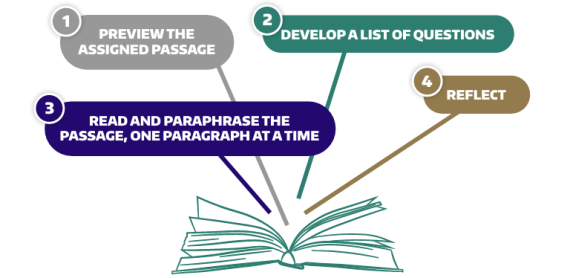Purpose of Active Reading
Your brain is better able to make sense of and retain new information if it first has the "big picture" of what it's about to learn. You can give your brain this big picture by previewing the assigned reading and creating a set of questions that the reading will answer for you. Then when you actually read the passage, your brain will be primed to look for answers to the questions you have created. You can ensure that your questions will be answered by paraphrasing the assigned passage in your own words as you read it. If the reading does not answer your questions to your satisfaction, then you have a set of thoughtful queries ready to bring to class or to office hours!
How to Read Actively:
Step 1: Preview the assigned passage (5-10 min)
Read the section headings, boldface and italicized print, and any tables or figures contained in the reading assignment. What words or phrases do you notice?
Step 2: Develop a list of questions (2-5 min)
Determine the purpose of the reading. Based on the words and phrases you noted in Step 1, what questions do you expect the reading to answer for you?
Step 3: Read and paraphrase the passage, one paragraph at a time (variable)
Read the first paragraph, then paraphrase it in your own words. Read the next paragraph and paraphrase it in your own words, but fold in the information from the previous paragraph as well. After reading the third paragraph, your paraphrase will contain all information from the previous two paragraphs. Continue in this fashion until you have read the entire passage.
It might seem like this will take much longer than simply reading the passage straight through, but consider this: is it easy to read a textbook passage straight through and fully retain all the information in one try? Chances are you said no. Your brain gets distracted during the middle of a paragraph, you get to the end realizing you didn’t remember any of it, and you have to start over from the top.
By paraphrasing each paragraph as you go, you will retain much more information. You will use your limited time far more efficiently, because you are only moving in one direction through the passage. In addition, you will have created a robust set of notes that you can use when reviewing for quizzes and exams.
IMPORTANT: Don't skip the worked examples!
The worked example problems in the reading assignments contain crucial information about how to apply the concepts and techniques you are reading about. If you skip over these, you are skipping some of the most important content in the reading!
Step 4: Reflect (5-10 min)
When you have finished reading and paraphrasing, ask yourself: Have all the questions I created in Step 2 been answered? Did the reading inspire any additional questions that I can bring to class or office hours?
"But what if I just don't have time to do all of this before class?"
That's ok! Your schedule may not allow a full active reading session for every pre-class reading assignment. At a minimum, you should complete Steps 1 and 2, which should take a combined 10-15 minutes. This can fit in a small window in your busy day. You can save the reading + paraphrasing step for later when you have more uninterrupted time.
Information in the Catalyze Your Success program has been adapted from learning strategies presented by the Louisiana State University Center for Academic Success and the book "Teach Students How to Learn" by Saundra Yancy McGuire, Stylus Publishing (2021).
